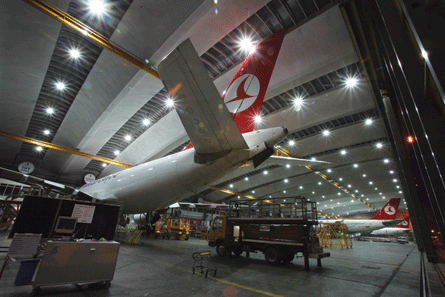Positioned between the Middle East and western and eastern Europe - and with a growing economy at home - Turkish Technic aims to capitalise on its location by building a huge new greenfield maintenance complex.
Named HABOM (the Turkish equivalent of maintenance, repair and overhaul centre), the facility is being built with international partners at Istanbul's Sabiha Gökçen International airport.
The opening of the Turkish Engine Centre in Istanbul in January 2010 was a significant addition to MRO capabilities in the region. The overhaul shop is a joint venture with Pratt & Whitney and services CFM56-3/5B/5C/7B as well as International Aero Engines V2500-A5 engines. The 25,000m² (270,000ft²) facility supports parent carrier Turkish Airlines as well as third-party customers, and has an annual capacity of about 200 overhauls.
 |
|---|
© Turkish TechnicTurkish Technic needs more hangars |
Fuelled partly by the parent carrier's own fleet growth, Turkish Technic is investing $500 million in a 372,000m² airframe and component maintenance centre, where it plans to employ 3,500 workers. This is more than the company currently employs (about 3,000), with its main base at Istanbul's Atatürk International airport. Turkish Airlines aims to increase its fleet size from 153 to 260 aircraft by 2015, including its cargo subsidiary and budget airline, Anadolujet.
After nearly three years of talks, the MRO provider signed an agreement with Goodrich last July to build a joint-venture repair shop for engine nacelles, thrust reversers and related components as part of the HABOM site. Named Goodrich Turkish Technic Service Center, the 2,000m² facility will initially employ 20 people and is scheduled to become operational in the first quarter of 2011. Staff numbers will grow to 70 over the next decade, and there are plans to double the size of the facility.
CABIN INTERIORS
The latest addition to the project is a cabin interior equipment joint venture between Turkish Airlines/Technic and Ankara-based Turkish Aerospace Industries, a move revealed in late December. The company, named Turkish Cabin Interior Systems, will design, manufacture and modify all types of individual components and entire systems, such as galleys, crew rest compartments and staircases.
Although Turkish Airlines/Technic chairman Hamdi Topcu emphasises that the project is one step on from offering just MRO services to include the manufacture of new equipment, it seems feasible that the venture might lead to a cabin interior MRO business in the future.
 |
|---|
© Turkish Technic |
ST Aerospace was also an early participant in the HABOM project. In 2005, the Singapore company signed a memorandum of understanding with Turkish Airlines for a 50% partnership in the future MRO base. This would have given ST Aero its first facility in the wider Middle East region, but the MoU has since expired without any further involvement in the project.
ST Aero has been serving the Middle East market for airframe, engine and component MRO "reasonably well" from its existing bases in Asia Pacific, the Americas and Europe, says company president Chang Cheow Teck. But it is now looking at establishing some kind of presence in the region, for example through partnerships or joint ventures, he adds.
"We see opportunities to further strengthen our network and better access the Middle East, North African and European markets through potential investments in the Middle East region. This is particularly so for the airframe support of narrowbody fleets in the Middle East, North African and European regions," he says.
Source: Flight International
















